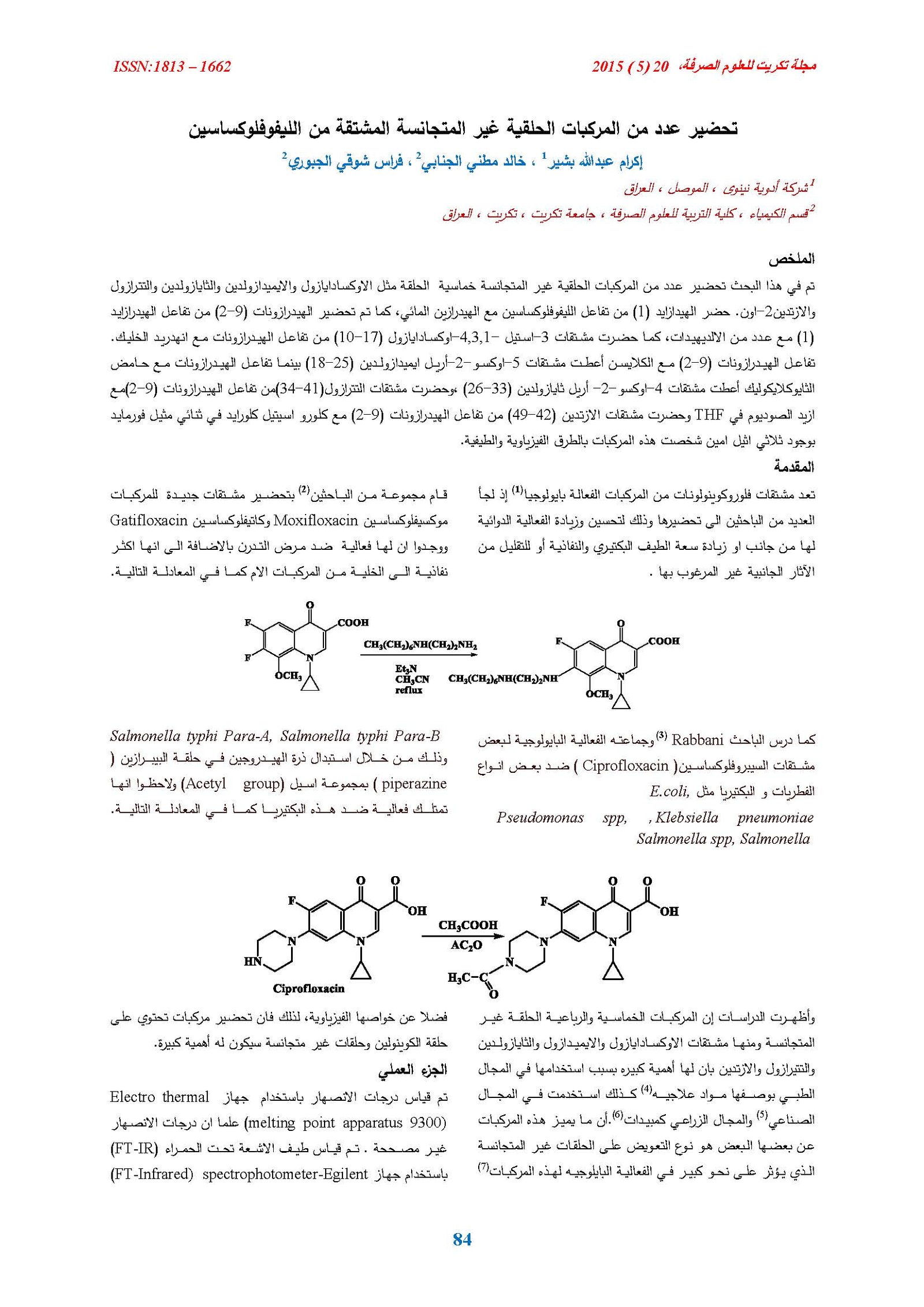Synthesis a Number of Heterocyclic Compounds Derived From Levofloxacin
Main Article Content
Abstract
In this paper, the preparation a number of heterocyclic compounds five membered rings like oxadiazole, imidazolidine, thiozolidine, tetrazole, azetidine 2-on. Hydrazide (1) was synthesized from the reaction of levofloxacin with hydrazine hydrate. Hydrazone compounds (2-9) were synthesized from the reaction (1) with a number of aldehydes, and 3-acetyl-1,3,4-oxadiazol (10-17) was prepared from the reaction of hydrazones (2-9) with acetic anhydride, 5-oxo-2-aryl imadazoldine derivative (18-25) were prepared from the reaction of hydrazone derivatives (2-9) with glycine, while the reaction of hydrazone with thioglygolic acid gave 4-oxo-2-aryl-thiozolidine (26-33),tetrazole derivative(34-41)prepared from the reaction of hydrazone(2-9) with sodium azide in tetrahyro furan.azetidine-2-on(42-49)with chloro acetyl chloride in DMF and and in the presence of triethyl amine these compounds were characterized on bases of spectral and physical data.
Article Details

This work is licensed under a Creative Commons Attribution 4.0 International License.
Tikrit Journal of Pure Science is licensed under the Creative Commons Attribution 4.0 International License, which allows users to copy, create extracts, abstracts, and new works from the article, alter and revise the article, and make commercial use of the article (including reuse and/or resale of the article by commercial entities), provided the user gives appropriate credit (with a link to the formal publication through the relevant DOI), provides a link to the license, indicates if changes were made, and the licensor is not represented as endorsing the use made of the work. The authors hold the copyright for their published work on the Tikrit J. Pure Sci. website, while Tikrit J. Pure Sci. is responsible for appreciate citation of their work, which is released under CC-BY-4.0, enabling the unrestricted use, distribution, and reproduction of an article in any medium, provided that the original work is properly cited.
References
[1] S. Garg and V. Sharma, VSRD International
Journal of Biotechnology & Pharmaceutical Sciences.
1(1),1-5 )2012).
[2] M. V. de Almeida, M F. Saraiva and A. Marcus,
Bioorganic and Medicinal Chemistry Letters, 17,
5661–5664 (2007).
[3] M. G.Rabbani, M. Islam, M. Ahmad and A. M.
Hossion Bangla- desh J Pharmacol ; 6, 8-13 (2011).
[4] S. Karakus and S. Rollas, IL Farmaco.,57 ,577-
581 (2002).
[5] V.P. and R.P.T.P., J. Serb. Chem. Soc. 77(11),
709-718 (2002).
[6] S.Cao, X.Qian,G.Song and Q.Huang, J. Fluorine
Chem. 117, 63-66 (2002).
[7] A.K. Sen-Gupta and H.K. Misra, 8,107; Chem.
Abstr. 93, 63389 (1980).
[8] H. G. Qiang and Y. Yong , Acta Pharmaceutica
Sinica, 45 (8), 1012-1016 (2010).
[9] F. Kh. I. Al-Hamdany, Ph. D. Thesis, University
of Mosul-Iraq, (2009).
[10] J. Tao, L. H. Cao, C.F. Wang and D. Z.
Wang, J. Chin. Chem. Soc., 53(5), 1193-1197,
(2006).
[11] A.W. Naser, Iraqi National Journal of
Chemistry, 50, 199-206 (2013).
[12] N. B. Patel and S. D. Patel, Der Pharma
Chemica, 1(2),199-209 (2009).
[13] L . R . Buti , M . Sc . Thesis ,University of
Mosul, Iraq, (2011).
[14] M. E. H. Al-mashhadany, M. Sc. Thesis,
University of Mosul, Mosul-Iraq, (2013).
[15] N.M. Hossini, S. Emami,and M.A. Faramarzi,
Journal of Pharmaceutical Sciences , 20(16), 1-6
(2012).
[16] H.G. Qiang and Y. Yong, Acta Pharmaceutica
Sinica, 45(8),1012-1016(2010).
[17] S. Ramachandran, P. Shhanmgapandiyan and C.N.Nalini, International Journal of Pharmaceutics Sciences and Research, 2(6), 1564-1568(2011).
[18] R. M. Silverstein, G. C. Bassler and T. C. Morrill, “Spectrometric Identification of Organic
Compounds’’, 3rd Edn., John Wiley & Sons, Inc. New York., 96, (1974).
[19] A. K. Khan, Ph. D. Thesis, University of Baghdad, Iraq, (2013) .
